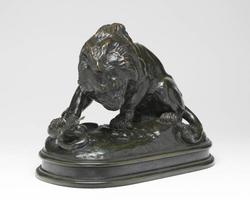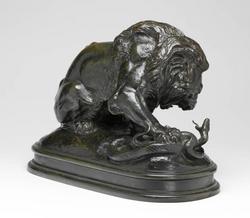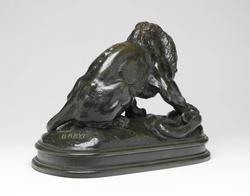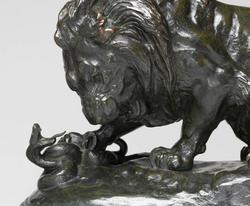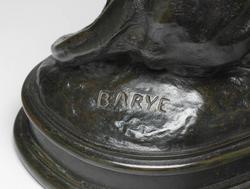Current Location: In storage
Titles
Lion au serpent no. 1
(Lion and serpent no. 1)
Maker(s)
Sculptor:
Barye, Antoine Louis
Entities
Categories
Description
Bronze. The moulded base is cast in one with the group - it is hollow cast - with dark brown patina, polished. The lion is seated on its haunches, looking down at the snake that it has pinned to the ground with its right paw. Its towering massive head and mane is supported by its left front leg. The word ''Barye'' is stamped on the base.
Notes
History note: Sotheby's, 21st July 1933, Anonymous Sale, lot 169; bought by the Barbizon Gallery, King Street, St James Square, from whom purchased by The Friends of the Fitzwilliam Museum
Legal notes
Given by the Friends of the Fitzwilliam Museum
Measurements and weight
Depth: 18.2 cm
Height: 25.8 cm
Width: 35.5 cm
Acquisition and important dates
Method of acquisition: Given
(1944)
by
The Friends of the Fitzwilliam Museum
Dating
19th Century
Production date:
after
AD 1845
: Date of original model 1838. Original model revised to include integrally-cast base c. 1845. Present model (with integral base) cast at an unknown date after 1845.
Note
Dubbed the ‘Michelangelo of the Menagerie’ by art critic Théophile Gautier (1811–72), Barye was a Romantic realist artist based in Paris who popularised the genre of animal sculpture from the 1830s onwards. Animals were very low down in the traditional Academic hierarchy of accepted subject-matter for artists, and the term animalier (an artist specialising in animals) was coined by critics specifically for Barye as a pejorative appellation. Barye was a successful monumental sculptor, but also created hundreds of small-scale models of animals for reproduction in bronze editions for middle-class homes. His last sales catalogue of 1865 listed over 230 compositions available to order as edition bronze statuettes. Keen for accuracy, Barye studied ancient animal sculptures as well as live beasts in the Musée d’Histoire Naturelle’s menagerie, copied zoological specimens in the Musée d’Anatomie Comparée and made anatomical drawings of dead lions. Bayre’s animal portraits include single animal figures (e.g. M.19-2015) and groups of predators with prey, or in combat with each other (e.g. M.1-2015), and some with human figures (e.g. M.5-2015).
The model for this bronze derives from a life-size plaster model made by Barye in 1832, which was exhibited at the Paris Salon in 1833. It was later cast into bronze for Louis-Philippe (King of France from 1830 to 1848), and exhibited at the 1836 Salon (now Louvre, Paris, L.P. 1184). The composition was intended as an allegory to flatter the king with the lion symbolic of courage, strength and good kingship triumphing over evil. It also commemorated the fact that in July 1830, when the Revolution saw Louis-Philippe placed on the French throne, Leo and Hydra were the ruling constellations.
Barye’s company produced different models derived from the original large sculpture at different dates and in different sizes. The sketch model with lion’s paw raised (known as Lion au serpent, no. 3 [esquisse]: see M.3-2015) dates from 1832; a further version, with a much rockier landscape surface (known as Lion au serpent, no. 2: see M.2-2015) was first cast in bronze in 1857. Although listed as No. 2, this was actually Barye’s third variant. The present model is the closest to the original sculpture with the lion and serpent on a flatter, less rocky surface and dates from c. 1838.
After Barye's death, the model for this version was one of 78 foundry models purchased at his 1876 studio sale by the Paris-based art dealer Hector-Henri-Clément Brame (1831-99) with the right to reproduce them. It is unclear whether the present version was cast during Barye's lifetime, or was a posthumous production by Brame.
School or Style
Animalier
Project
Materials used in production
Copper alloy
Bronze
Techniques used in production
Casting (process)
: Cast, bronze, patinated
Patination
Inscription or legends present
- Text: Barye
- Location: On base
- Method of creation: Stamped
- Type: Signature
References and bibliographic entries
Identification numbers
Accession number: M.1-1944
Primary reference Number: 13599
External ID: CAM_CCF_M_1_1944
Stable URI
Audit data
Created: Saturday 6 August 2011
Updated: Monday 29 April 2024
Last processed: Tuesday 29 July 2025
Associated departments & institutions
Owner or interested party:
The Fitzwilliam Museum
Associated department:
Applied Arts
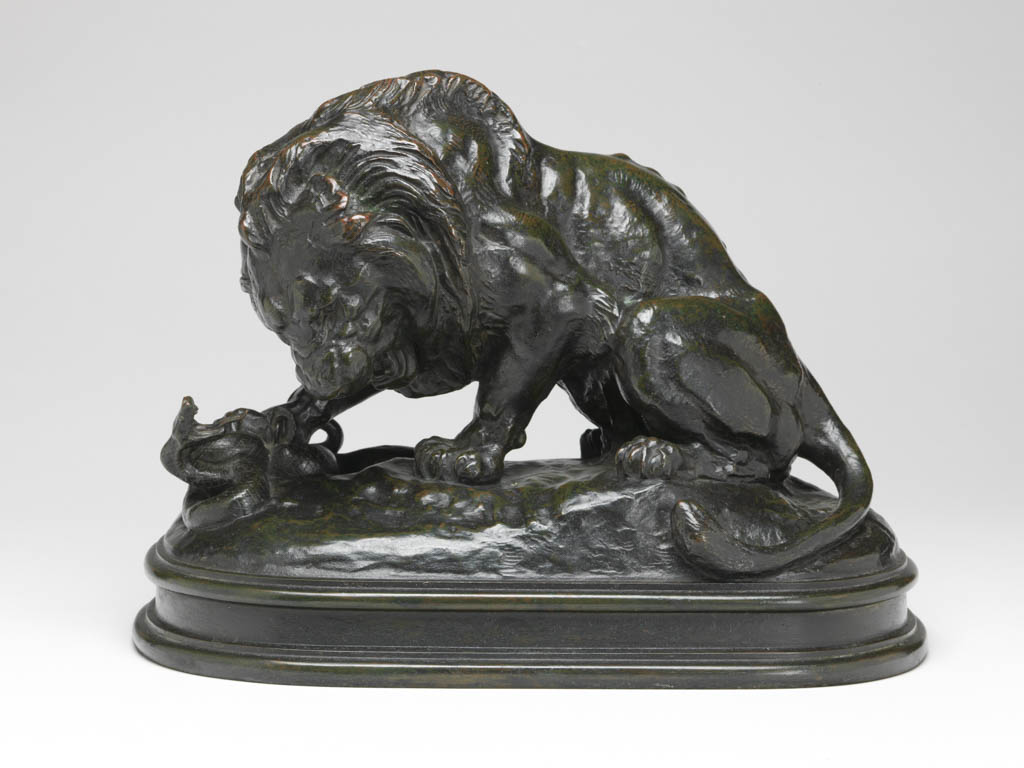
 IIIF Manifest
IIIF Manifest
